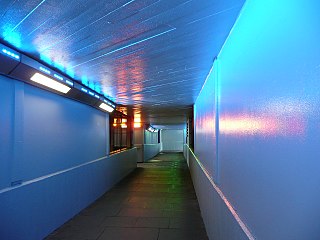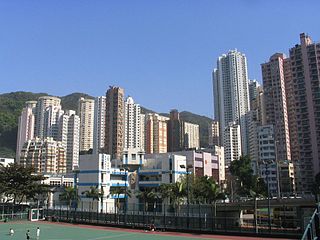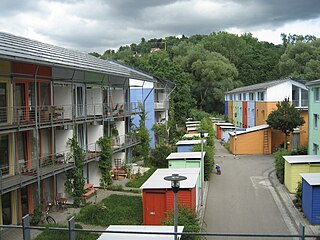 W
WThe 491 Gallery was a squatted self-managed social centre and multi-disciplinary gallery in Leytonstone, London, England, that operated from 2001 to 2013. Taking its name from its street number, 491 Grove Green Road, the former factory was home to a community-led art organisation and served as an exhibition space for a diverse range of artists of different origins working in varied media. It contained a range of art and music studios, which were used to host workshops, classes and musical rehearsals. The building was subsequently demolished in 2016.
 W
WAvinguda de la Llum is a now-closed underground mall in Barcelona, the first one of its kind to open in Europe, open between 1940 and 1990, on a 2000 square-metre site built in 1929 and boasting 68 commercial establishments, including a movie theater. It was underneath Carrer de Pelai, between Plaça de Catalunya, Carrer de Balmes, Carrer de Bergara and Plaça de la Universitat, upstairs of the Ferrocarrils de la Generalitat de Catalunya (FGC) station Catalunya, between its vaults and the street.
 W
WBlitz is an anarchist, communist and socialist youth community in Oslo, Norway, founded in 1982.
 W
WCabaret Voltaire was the name of an artistic nightclub in Zürich, Switzerland. It was founded by Hugo Ball, with his companion Emmy Hennings, in the back room of Holländische Meierei, Spiegelgasse 1, on February 5, 1916, as a cabaret for artistic and political purposes. Other founding members were Marcel Janco, Richard Huelsenbeck, Tristan Tzara, and Sophie Taeuber-Arp and Jean Arp. Events at the cabaret proved pivotal in the founding of the anarchic art movement known as Dada. It closed in the summer of 1916.
 W
WThe Cairo apartment building, located at 1615 Q Street NW in Washington, D.C., is a landmark in the Dupont Circle neighborhood and the District of Columbia's tallest residential building. Designed by architect Thomas Franklin Schneider and completed in 1894 as the city's first "residential skyscraper", the 164-foot (50 m)-tall brick building spurred local regulations and federal legislation that continue to shape Washington's cityscape.
 W
WCardboard City was the name for an informal settlement composed of cardboard box dwellers near Waterloo station in London, England, lived in by homeless people from 1978 until 1998.
 W
WCornwall Terrace is a Grade I listed building of consecutive terraced mansions overlooking Regent's Park in the City of Westminster, London. It is situated at the park's southwest corner, near Baker Street, between York Terrace and Clarence Terrace, within the park's Crown Estate development. Cornwall Terrace was part of the scheme of the Prince Regent, later King George IV, to develop grand housing in Regent's Park. The buildings are Grade I listed buildings.
 W
WThe Duitse Huis is a complex of buildings in the city of Utrecht, Netherlands, protected as a national monument. The older parts date to a monastery of the Bailiwick of Utrecht of the Teutonic Knights founded in 1348. Originally Catholic, the order became Protestant during the Reformation. A military hospital was added in 1823 after the knights had sold the property. The property was sold back to the Bailiwick of Utrecht and a major renovation started in 1992. Some of the older buildings are again the headquarters of the Bailiwick of Utrecht, now a charity, and hold an important collection of medieval manuscripts, coins and pictures. Other buildings, including the former hospital, have been converted into a five-star hotel, the Grand Hotel Karel V.
 W
WThe Entrepotdok, formerly Nieuwe Rapenburgergracht, is a canal in Amsterdam, and a street and row of former warehouses with the same name along the northeast side of the canal. They were constructed between 1708 and 1829, used for storage, squatted in the 1990s and are now converted into apartments. Entrepotdok is the largest inhabited warehouse complex in Amsterdam. The canal runs between the Kadijksplein and Sarphatistraat, and is parallel to Hoogte Kadijk, Laagte Kadijk, Plantage Doklaan and Natura Artis Magistra zoo.
 W
WFife House, No 1, Lewes Crescent, is a Grade I listed building in Kemp Town, Brighton, United Kingdom, which was previously owned by the Duke of Devonshire and the Duke of Fife.
 W
WThe Freedom Tunnel is the name given to the railroad tunnel on the West Side Line under Riverside Park in Manhattan, New York City. Currently used by Amtrak trains to and from Pennsylvania Station, it got its name because the graffiti artist Chris "Freedom" Pape used the tunnel walls to create some of his most notable artwork. The name may also be a reference to the former shantytowns built within the tunnel by homeless populations seeking shelter and freedom to live rent-free and unsupervised by law enforcement. The tunnel runs approximately 2.6 miles (4.2 km), from 72nd Street to 124th Street.
 W
WKowloon Walled City was an ungoverned, densely populated de jure Chinese enclave within the boundaries of Kowloon City, Hong Kong. Originally a Chinese military fort, the walled city became an enclave after the New Territories were leased to the UK by China in 1898. Its population increased dramatically following the Japanese occupation of Hong Kong during World War II. By 1990, the walled city contained 50,000 residents within its 2.6-hectare (6.4-acre) borders. From the 1950s to the 1970s, it was controlled by local triads and had high rates of prostitution, gambling, and drug abuse.
 W
WKulturfabrik Esch-sur-Alzette (KuFa) is a cultural centre located in a former slaughterhouse in the city of Esch-sur-Alzette in the Grand Duchy of Luxembourg. As of 2019, the state-funded centre attracts almost 80,000 visitors a year.
 W
WOval Mansions are eight separate blocks of tenement housing in Kennington, south London. The blocks stand between the Oval cricket ground and the Oval Gasholders. After being occupied by one hundred squatters from 1983 until 2000, the buildings were sold off by Lambeth Council in the early 2000s.
 W
WRunway 18 West is a 4000 meter long runway at Frankfurt Airport, which is located in its western part and runs from north to south. The smaller northern part is located in the Frankfurt district of Flughafen,the larger southern part on the district Rüsselsheim am Main. Before the runway went into operation in 1984, the plans met with considerable protest and became one of the most important points of reference for the German environmental movement of the 1970s and 1980s.
 W
WShek Kip Mei, originally known as Shek Kap Mei (石夾尾), is an area in New Kowloon, to the northeast of the Kowloon Peninsula of Hong Kong. It borders Sham Shui Po and Kowloon Tong.
 W
WThe Kunsthaus Tacheles was an art center in Berlin, Germany, a large building and sculpture park on Oranienburger Straße in the district known as Mitte. Huge, colorful graffiti-style murals were painted on the exterior walls, and modern art sculptures were featured inside. The building housed an artists collective from 1990 until 2012.
 W
WTai Hang is an area southeast of Causeway Bay located in the mid-north of Hong Kong Island in Hong Kong. The area was originally a slum, until its redevelopment after the 1990s.
 W
WThe Teatro Valle is a theatre and former opera house in Rome, Italy. It was built in 1726 for the Capranica family. In the middle of the 19th century, it switched from staging opera and theatre to only performances of spoken drama. After closing down in 2010, it was squatted in 2011, then evicted in 2014.
 W
WVauban [] is a neighbourhood to the south of the town centre in Freiburg, Germany. It was built as "a sustainable model district" on the site of a former French military base named after Sébastien Le Prestre de Vauban, the 17th century French Marshal who built fortifications in Freiburg while the region was under French rule. Construction began in 1998, and the first two residents arrived in 2001.
 W
WWindsor Castle is a royal residence at Windsor in the English county of Berkshire. It is strongly associated with the English and succeeding British royal family, and embodies almost 1,000 years of architectural history.